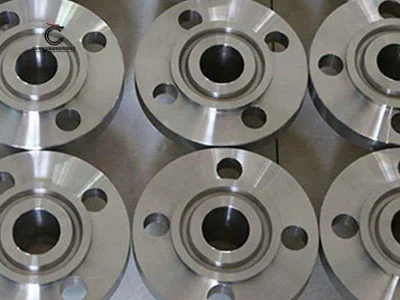What Makes ANSI B16.5 Steel Flange So Special
ANSI B16.5 steel flange is a flange widely used in various industries. It is designed to connect pipes, valves, and other equipment in the piping system. The ANSI B16.5 standard specifies dimensions, materials, and testing requirements for steel flanges. In this article, we'll discuss its features.

1. Material: ANSI B16.5 steel flange is made of carbon steel, stainless steel, alloy steel, and other materials. The material used depends on the application and environment of the flange. Carbon steel flanges are typically used for low-pressure applications, while stainless steel and alloy steel flanges are used for high-pressure and high-temperature applications.
2. Size: ANSI B16.5 steel flanges range in size from 1/2" to 24". The size of a flange depends on the size of the pipe it is designed to connect to.
3. Pressure rating: ANSI B16.5 steel flanges are designed to withstand specific pressures. The pressure rating of the flange is determined by the material, size, and design of the flange, the most common pressure ratings are 150, 300, 600, 900, 1500, and 2500.
4. Flange faces: ANSI B16.5 steel flanges can have different types of flange faces, including convex, flat, and ring joint faces. The flange face is the surface that contacts the gasket and mating flange.
5. Bolt holes: ANSI B16.5 steel flanges have bolt holes for fixing the flange to the mating flange. The number and size of bolt holes depend on the size and pressure rating of the flange.
6. Gaskets: ANSI B16.5 steel flanges require gaskets to form a seal between the flanges. The type of gasket used depends on the application and environment of the flange.
7. Flange type: There are many types of ANSI B16.5 steel flanges, including slip-on type, butt-welding type, threaded type, lap joint type, and blind plate type. The type of flange used depends on the application and the type of connection required.
8. Testing: ANSI B16.5 steel flanges undergo various testing procedures to ensure their quality and performance. This standard specifies the test requirements for flanges, including hydrostatic test, visual inspection, and dimensional inspection. These tests are performed to ensure that the flanges meet the required standards and are suitable for use in the piping system.
9. Standard: ANSI B16.5 steel flanges are designed in accordance with the standards established by the American National Standards Institute (ANSI). These standards ensure that flanges are of high quality and meet industry requirements.
In summary, ANSI B16.5 steel flanges are an important part of many industries. They are durable, reliable, and easy to install. The characteristics of these flanges make them suitable for a wide range of applications from low-pressure systems to high-pressure systems. When selecting, it is important to consider material, size, pressure rating, flange faces, bolt holes, gaskets, and standards to ensure the flange meets the application requirements.

Are you working on a piping project and in need of a reliable, high-quality flange to join the pipes securely? Look no further than ANSI B16.5 steel flanges! These types of flanges are widely used in various industries due to their exceptional features, making them stand out from other options available in the market. In this blog post, we will explore what makes ANSI B16.5 steel flanges so special by discussing their different types, key features, and how to choose the right one for your project. So let's dive into it!
What is ANSI B16.5 steel flange?
ANSI B16.5 steel flanges are a type of industrial component used in piping and plumbing systems to connect pipes, valves, pumps or other equipment together. They provide a secure and leak-proof connection between two flanged components by using bolts to compress the gasket between them.
The ANSI B16.5 standard is recognized worldwide as the most common standard for pipe flanges. It specifies dimensions such as bolt circle diameter, number of holes, bolt size and length that must be adhered to when manufacturing these types of flanges.
Steel is the most preferred material for ANSI B16.5 flanges because it offers high strength, durability and corrosion resistance required in demanding industrial environments. The steel used can vary from low carbon steels (A105) to high alloy materials like stainless steel (F304/F316).
There are different classes available depending on the pressure rating needed for your application ranging from Class 150 up to Class 2500 which can handle pressures up to 40 MPa (5800 psi). In summary, an ANSI B16.5 steel flange is a crucial component that provides reliable connections in various industries while adhering to strict standards for quality assurance purposes.
The Different Types of ANSI B16.5 steel flange
There are several types of ANSI B16.5 steel flanges, each designed for specific applications in different industries. The most common type is the weld neck flange, which has a long tapered hub that provides an ideal connection point for pipes and fittings.
Another popular option is the threaded flange, which can be easily screwed onto pipes without additional welding or soldering. This makes it a great choice for low-pressure applications where ease of installation is important.
For high-pressure applications, the socket weld flange is often used due to its ability to provide excellent strength and durability. It features a recessed area that allows pipes to fit snugly into the flange and then welded together.
Slip-on flanges are also commonly used in low-pressure systems as they require less time and effort to install than other types. They simply slide over the pipe end before being welded into place.
Blind flanges are utilized when there's a need to close off piping ends securely without creating any connections. These come with no bore or opening but can have bolt holes around their perimeter for attachment purposes.
Choosing the right type of ANSI B16.5 steel flange involves considering factors like pressure rating, temperature range, pipe size compatibility and material requirements – factors that will ultimately determine how well your system performs over time.
The Features of ANSI B16.5 steel flange
The ANSI B16.5 steel flange is known for its remarkable features that make it a popular choice in various industries. One of its key features is its durability, which makes it resistant to corrosion and other forms of wear and tear. This means that the flanges can withstand harsh conditions, making them ideal for use in demanding applications.
Another feature that sets the ANSI B16.5 steel flange apart from others is its versatility. It comes in different sizes, pressure ratings, and materials such as carbon steel, stainless steel, alloy steel among others; allowing you to choose the right one depending on your specific requirements.
Additionally, these flanges have excellent sealing capabilities due to their design which ensures tight connections between pipes or valves preventing any leaks during operations. They also offer easy installation thanks to their standard dimensions and bolt-hole patterns.
Furthermore, the ANSI B16.5 steel flange has high temperature resistance properties enabling them to function optimally even at extreme temperatures without losing structural integrity or experiencing thermal deformation issues.
The ANSI B16.5 Steel Flange offers unmatched quality with exceptional features like durability under harsh conditions due to resistance against wear & tear while providing versatile options available in various sizes & materials with amazing sealing capacity ensuring leak-free performance along with easy installation procedures together with high-temperature resistivity make it an ideal component used across multiple industrial sectors worldwide.
How to Choose the Right ANSI B16.5 steel flange for Your Project
Choosing the right ANSI B16.5 steel flange for your project is crucial to ensure its success and longevity. The first step in selecting the ideal flange is to consider the requirements of your specific application, such as temperature, pressure, and fluid compatibility.
Next, determine the size and type of flange needed for your piping system. ANSI B16.5 steel flanges come in a variety of sizes, from 1/2 inch to over 60 inches in diameter, so it's essential to choose one that fits properly with your pipe connections.
Consider the material used for manufacturing the flange - carbon steel or stainless steel - as each has unique properties that can impact performance under certain conditions.
Ensure you take into account additional factors such as corrosion resistance, sealing ability and stability when choosing an ANSI B16.5 steel flange suitable for marine applications.
Check if there are any specific industry standards or regulations that need compliance before purchasing an ANSI B16.5 steel flange.
By considering all these aspects while selecting an appropriate ANSI B16.5 Steel Flange will result in optimum results and avoid future problems during installation or operation of equipment which saves time & resources both at once!
Conclusion
ANSI B16.5 steel flanges are an important component in various industrial applications due to their exceptional strength and durability. They come in different types and sizes to meet the requirements of different projects.
When choosing the right ANSI B16.5 steel flange for your project, it is crucial to consider factors such as pressure rating, material type, gasket type, size range, and application environment. By doing so, you can ensure that you get a high-quality product that will perform optimally throughout its lifespan.
If you are looking for a reliable and long-lasting solution for connecting piping systems or vessels together securely and efficiently while ensuring safety and quality assurance standards are met - then ANSI B16.5 steel flanges should be at the top of your list!
What is the definition of blind flange? What is the ANSI B16.5 steel flange material?






